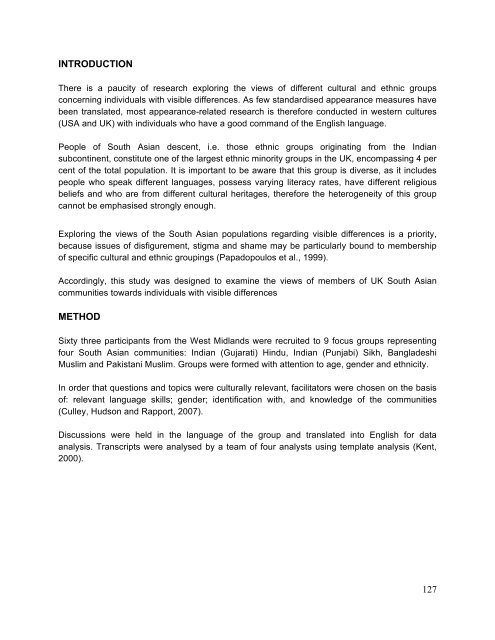Download the report - The Healing Foundation
Download the report - The Healing Foundation
Download the report - The Healing Foundation
You also want an ePaper? Increase the reach of your titles
YUMPU automatically turns print PDFs into web optimized ePapers that Google loves.
INTRODUCTION<br />
<strong>The</strong>re is a paucity of research exploring <strong>the</strong> views of different cultural and ethnic groups<br />
concerning individuals with visible differences. As few standardised appearance measures have<br />
been translated, most appearance-related research is <strong>the</strong>refore conducted in western cultures<br />
(USA and UK) with individuals who have a good command of <strong>the</strong> English language.<br />
People of South Asian descent, i.e. those ethnic groups originating from <strong>the</strong> Indian<br />
subcontinent, constitute one of <strong>the</strong> largest ethnic minority groups in <strong>the</strong> UK, encompassing 4 per<br />
cent of <strong>the</strong> total population. It is important to be aware that this group is diverse, as it includes<br />
people who speak different languages, possess varying literacy rates, have different religious<br />
beliefs and who are from different cultural heritages, <strong>the</strong>refore <strong>the</strong> heterogeneity of this group<br />
cannot be emphasised strongly enough.<br />
Exploring <strong>the</strong> views of <strong>the</strong> South Asian populations regarding visible differences is a priority,<br />
because issues of disfigurement, stigma and shame may be particularly bound to membership<br />
of specific cultural and ethnic groupings (Papadopoulos et al., 1999).<br />
Accordingly, this study was designed to examine <strong>the</strong> views of members of UK South Asian<br />
communities towards individuals with visible differences<br />
METHOD<br />
Sixty three participants from <strong>the</strong> West Midlands were recruited to 9 focus groups representing<br />
four South Asian communities: Indian (Gujarati) Hindu, Indian (Punjabi) Sikh, Bangladeshi<br />
Muslim and Pakistani Muslim. Groups were formed with attention to age, gender and ethnicity.<br />
In order that questions and topics were culturally relevant, facilitators were chosen on <strong>the</strong> basis<br />
of: relevant language skills; gender; identification with, and knowledge of <strong>the</strong> communities<br />
(Culley, Hudson and Rapport, 2007).<br />
Discussions were held in <strong>the</strong> language of <strong>the</strong> group and translated into English for data<br />
analysis. Transcripts were analysed by a team of four analysts using template analysis (Kent,<br />
2000).<br />
127


